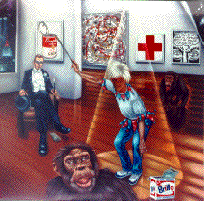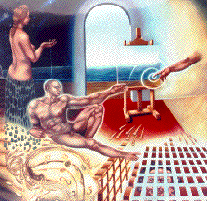
 Separated Realities, By Mariu Suarez
|
 Diptych - 58"x57" each panel |
Since then, neither the Guggenheim, nor any other major player in the American art establishment, has bothered to show any neutrality. In fact, in 1941, Surrealism was declared dead and has been described as such in all art history books since that time. Therefore, the hundreds of artists working in this style who are originally from, or live in, the United States, have received no attention from critics, galleries or museums. This has left them outside the reach of three generations of Americans who, by and large, are unaware of the work done by surrealists during the second half of the century.
Michael S. Bell, a specialist in American Art, researched the surrealist phenomena while he was Curatorial Assistant at the Museum of Modern Art in San Francisco. His research led him to the conclusion that:
| "It remains a dire need, if truth be still an honorable cause, to set forth an option upon the records of time by which considerate humanity might judge for itself the merits and the players in one of our century's most vilified and degraded forms of expression." |
Surrealism as we know it today is closely related to some forms of abstract art. In fact, they shared similar origins, but they diverged on their interpretation of what those origins meant to the aesthetic of art.
At the end of the First War World, Tristan Tzara, leader of the Dada movement, wanted to attack society through scandal. He believed that a society that creates the monstrosity of war does not deserve art, so he decided to give it anti-art–not beauty but ugliness. With phrases like Dada destroys everything! Tzara wanted to offend the new industrial commercial world–the bourgeoisie. However, his intended victims were not insulted at all. Instead they thought that this rebellious new expression opposed, not them but the "old art" and the "old patrons" of feudalism and church dominion. In fact, the bourgeoisie embraced this "rebellious" new art so thoroughly that anti-art became Art, the anti-academy the Academy, the anti-conventionalism the Convention, and the rebellion through chaotic images, the status quo.
One group of artists, however, did not embrace this new art that threw away all which centuries of artists had learned and passed on about the craft of art. The Surrealist movement gained momentum after the Dada movement. It was lead by Andre Breton, a French doctor who had fought in the trenches during the First World War. The artists in the movement researched and studied the works of Sigmund Freud and Carl Jung. Some of the artists in the group expressed themselves in the abstract tradition, while others, expressed themselves in the symbolic tradition.
Two Distinct Groups Emerge
Michael S. Bell, through his research, realized that these two forms of expression formed two distinct trends of surrealism with marked differences. One could be qualified as Automatism, the other, as Veristic Surrealism. "Automatism" explains Mr. Bell, "is a form of abstraction. It has been the only type of surrealism accepted by critical reviewers after the war."
Basically, two different interpretations of the works of Freud and Jung divided the two groups. For the purpose of personal analysis, Jung had talked about not judging the images of the subconscious, but simply accepting them as they came into consciousness so they could be analyzed. This was termed Automatism.
-
When psychology talked about Automatism, these artists interpreted it as referring to a suppression of consciousness in favor of the subconscious. This group, being more focused on feeling and less analytical, understood Automatism to be the automatic way in which the images of the subconscious reach the conscience. They believed these images should not be burdened with "meaning."
Faithful to this interpretation, the Automatists saw the academic discipline of art as intolerant of the free expression of feeling, and felt form, which had dominated the history of art, was a culprit in that intolerance. They believed abstractionism was the only way to bring to life the images of the subconscious. Coming from the Dada tradition, these artists also linked scandal, insult and irreverence toward the elite's with freedom. They continued to believe that lack of form was a way to rebel against them.
-
This group, on the other hand, interpreted Automatism to mean allowing the images of the subconscious to surface undisturbed so that their meaning could then be deciphered through analysis. They wanted to faithfully represent these images as a link between the abstract spiritual realities, and the real forms of the material world. To them, the object stood as a metaphor for an inner reality. Through metaphor the concrete world could be understood, not by looking at the objects, but by looking into them.
Veristic Surrealists, saw academic discipline and form as the means to represent the images of the subconscious with veracity; as a way to freeze images that, if unrecorded, would easily dissolve once again into the unknown. They hoped to find a way to follow the images of the subconscious until the conscience could understand their meaning. The language of the subconscious is the image, and the consciousness had to learn to decode that language so it could translate it into its own language of words.
Later, Veristic Surrealism branched out into three other groups (see Research on Surrealism In America).
Every profession has its own history in which the accumulation of knowledge is the basis to push the frontiers into the unknown. Dali and Picasso are two masters who stand at the vanguard of two opposite approaches to art in the Twentieth Century: To use that accumulated knowledge and build upon it, or to discard it.
Dali embraced all the science of painting as a way to study the psyche through subconscious images. He called this process the Paranoiac Critical Method. As any paranoiac, the artist should allow these images to reach the conscience, and then do what the paranoiac cannot do: Freeze them on canvas to give consciousness the opportunity to comprehend their meaning. Later on, he expanded the process into the Oniric-Critical Method, in which the artist pays attention to his dreams, freezing them through art, and analyzing them as well. As Freud said, "A dream that is not interpreted is like a letter that is not opened."
Picasso took the opposite approach to art. He inherited the gusto for ugliness, scandal and chaos of the Dada movement and the automatic surrealists. Picasso rejected the craft to become "primitive," deciding that the ingenuity of childhood is the basis of art. To him this meant that the less the artist is preoccupied with his craft the better his art. To Dali, however, the "ingenuity of childhood" meant keeping an open mind and maintaining the curiosity and excitement of the child throughout one's life, not painting as a child.
The Struggle of Surrealism
For the automatists the approach to the mystery of Nature is to never become conscious of the mystery, for the surrealists it is to learn from it. The Picasso camp, won the "faith" of society. The Dali camp would have to secure a dialog with the public to be able to show the individual the "surrealist way of life" or the "path of individuation" as Jung called it.
The Veristic Surrealist quest is none other than the one described by Breton as, "The cause of freedom and the transformation of man's consciousness." In the works of surrealists we find the legacy of Bosch, Brueguel, William Blake, the Symbolic painters of the Nineteenth Century, the perennial questioning of philosophy, the search of psychology, and the spirit of mysticism. It is work based on the desire to permit the forces that created the world to illuminate our vision, allowing us to consciously develop our human potential.
The Veristic surrealists of today recognize the difficulties that their movement has faced during the second half of the Twentieth Century as it attempted to become a major cultural force, like modernism had. The United States, a country in which the business community never had to share its power with the aristocracy, wholeheartedly embraced abstraction and modernism. They shared the belief of abstract artists that the chaos of action painting and automatism were expressions of freedom, and that form, subjugation and inhibition walked hand in hand.
The American art establishment looked at the image of form with mistrust until the advent of Pop Art, which glorified the imperialism of commerce, advertisement and marketing. Later, Photorealism which glorified modern life, was accepted. With these two movements Realism entered the cultural picture again (see Art Through the Ages). Therefore, the only historical artistic expression still in want of recognition as a cultural force in the Twentieth Century, is Veristic Surrealism.
The Future of Surrealism
Because it was ignored and rejected by the new academy of modernism, Veristic Surrealism in its evolution has become a new art. A new art that in the words of Donald Kuspit, "Must first show that it has democratic appeal–appeal to those generally unschooled in art or not professionally interested in it. Then it must suffer a period of aristocratic rejection by those schooled in an accepted and thereby 'traditional' form of art–those with a vested interest in a known art and concerned with protecting it at all costs."
Contemporary Veristic Surrealists have worked for the past fifty years in silent seclusion. A renaissance of this art form will provide the world with new eternal aesthetic pleasures and reawaken the use of meaningful expression in art, so that it can once again have a dialogue with the public.
It would take fifty years for artists born after the Second World War to discover how right this method is for helping us all understand the architecture of the psyche. Those who have understood the method, who have faithfully followed the images of the subconscious and, with patience, painted and analyzed them, have a lot to teach us about the make up and interaction of the three planes of the Spiritual, the psychological, and the physical.
This page is maintained by Monica Sanchez. Your comments are welcomed.


